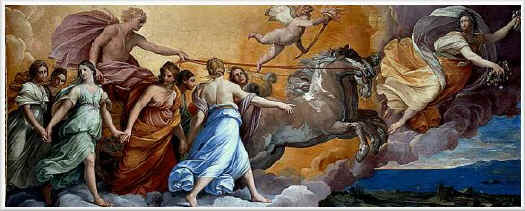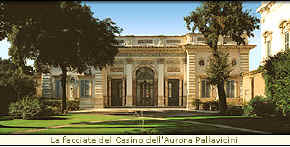
 Stein Collectors International
Stein Collectors International
Featured Stein: June 2006

 Stein Collectors International
Stein Collectors International
Featured Stein: June 2006
~ Aurora, The Dawn Goddess ~
by Walter B. Vogdes
This article was written as a companion to one which appeared in the June 2006 issue of Prosit. That article, authored by Rick Grunin, discusses the history and origins of Royal Vienna and Royal Vienna Type steins, and illustrates a number of different examples. This article focuses on one of those steins, and explains the theme which it displays. The title of the scene on this stein, marked on the base, is "Aurora." That is the name by which the Romans knew the goddess of the Dawn (although the Greeks called her Eos). Often referred to as "the rosy-fingered Dawn", it was her job to ride to Mt. Olympus each day to announce the approach of her brother, Sol (the sun), driving the darkness of the night away as she journeyed. (Unfortunately, at the time this stein was decorated, the sun had taken center stage and Aurora had moved to the far right of the scene, not visible in this photo.) The figure seen at upper left is young Apollo. He holds the reins of the chariot of the sun, being pulled by the horses Lampus and Phaethon. Apollo rose very morning from the ocean in the east and rode in the Sun chariot across the sky. Every evening he descended from the chariot in the west, leaving his attendants to tend the horses. The young women attendants are the Hours, dancing around the sun. Above the horses and between the chariot and Dawn is the winged putto of Twilight. The full image of this scene, which is drawn from an early 17th century painting by Italian painter Guido Reni, provides a better overall understanding of the composition of this scene.  "L'Aurora" by Guido Reni (1575-1642), completed in 1614 Here we see the full drama of the scene, as Dawn leads the way into the still dark early morning sky, followed by the chariot of the Sun, driven by Apollo and wrapped in a blazing nimbus signaling the day.  If
it were possible, Reni would probably have chosen to paint this scene across the
sky. Failing in that, he painted it as a fresco on the ceiling of a large
central hall in a garden pavilion of the Palazzo Pallavicini-Rospigliosi,
the papal palace of Cardinal Scipione Borghese in Rome. Known as the Casino
dell'Aurora, the fresco may be viewed by the public on the first day of each
month (except January). If
it were possible, Reni would probably have chosen to paint this scene across the
sky. Failing in that, he painted it as a fresco on the ceiling of a large
central hall in a garden pavilion of the Palazzo Pallavicini-Rospigliosi,
the papal palace of Cardinal Scipione Borghese in Rome. Known as the Casino
dell'Aurora, the fresco may be viewed by the public on the first day of each
month (except January).from Bullfinch's Mythology The Age of Fable Aurora, the goddess of the Dawn, like her sister the Moon, was at times inspired with the love of mortals. Her greatest favorite was Tithonus, son of Laomedon, king of Troy. She stole him away, and prevailed on Jupiter to grant him immortality; but forgetting to have youth joined in the gift, after some time she began to discern, to her great mortification, that he was growing old. When his hair was quite white she left his society; but he still had the range of her palace, lived on ambrosial food, and was clad in celestial raiment. At length he lost the power of using his limbs, and then she shut him up in his chamber, whence his feeble voice might at times be heard. Finally she turned him into a grasshopper. Memnon was the son of Aurora and Tithonus. He was king of the Æthiopians, and dwelt in the extreme east, on the shore of Ocean. He came with his warriors to assist the kindred of his father in the war of Troy. King Priam received him with great honors, and listened with admiration to his narrative of the wonders of the ocean shore. The very day after his arrival, Memnon, impatient of repose, led his troops to the field. Antilochus, the brave son of Nestor, fell by his hand, and the Greeks were put to flight, when Achilles appeared and restored the battle. A long and doubtful contest ensued between him and the son of Aurora; at length victory declared for Achilles, Memnon fell, and the Trojans fled in dismay. Aurora, who from her station in the sky had viewed with apprehension the danger of her son, when she saw him fall, directed his brothers, the Winds, to convey his body to the banks of the river Esepus in Paphlagonia. In the evening Aurora came, accompanied by the Hours and the Pleiads, and wept and lamented over her son. Night, in sympathy with her grief, spread the heaven with clouds; all nature mourned for the offspring of the Dawn. The Æthiopians raised his tomb on the banks of the stream in the grove of the Nymphs, and Jupiter caused the sparks and cinders of his funeral pile to be turned into birds, which, dividing into two flocks, fought over the pile till they fell into the flame. Every year at the anniversary of his death they return and celebrate his obsequies in like manner. Aurora remains inconsolable for the loss of her son. Her tears still flow, and may be seen at early morning in the form of dew-drops on the grass. |